April 2016
Honoring Yesterday – Protecting Tomorrow
Vol. 47, No. 4
April Calendar of Events
Mon.-Weds., April 11-13
California Retired County Employees Association (CRCEA) Conference
Bakersfield
Thurs., April 14, 9:30am
RESDC Board of Directors Meeting
8825 Aero Drive, Suite 205
Thurs., April 21, 8:30am
SDCERA Board of Retirement Meeting
2275 Rio Bonito Way, Suite 200
Tues., April 26, 12:00 Noon
RESDC General Membership Meeting
Serra Mesa Library
9005 Aero Dr.
April General Membership Meeting
 When: Tuesday, April 26, 2016
When: Tuesday, April 26, 2016
Time: 12:00 Noon
Place: Serra Mesa-Kearny Mesa Public Library
9005 Aero Dr., San Diego, CA 92123
Speakers: Marcela Guerra-Cordova, from Aging & Independence Ombudsman Program
Linda Hopkins, from Retired & Senior Volunteer Program (RSVP)
Directions to Serra Mesa-Kearny Mesa Public Library: Take I-15 to Aero Dr. West. Drive 1.1 miles. Library is on the left. There is a large parking lot with ample room for library patrons and RESDC members attending the meeting. Click here to view the library on Google Maps.
Planning to attend? Visit www.resdc.net/resdc-events or call (619) 688-9229 to RSVP.
President’s Message
By John J. McTighe
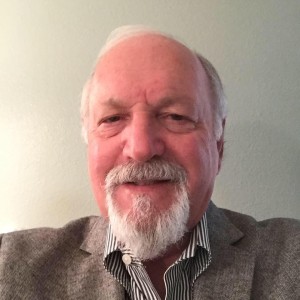
Last month I summarized the presentation that San Diego County Employees Retirement Association (SDCERA) CEO David Wescoe gave at our general membership meeting in January. As promised, this month I will highlight the remarks made by SDCERA’s new in-house Chief Investment Officer, Stephen Sexauer. You may recall that SDCERA underwent a significant change in direction and staffing over the past year, moving from an organization model that had placed the investment management with a contracted outside firm, Salient Partners, to a Chief Investment Officer employed by SDCERA. Mr. Sexauer started in that position on May 29, 2015. His initial responsibility was to oversee the transitioning of asset management from Salient Partners and to develop a longer term Investment Policy Statement (IPS) for consideration and adoption by SDCERA’s Board of Retirement.
By way of background, Mr. Sexauer came to SDCERA with 30 years of investment industry experience, which included working at Allianz Global Investors as Chief Investment Officer managing over $7 billion in multi-asset institutional portfolios and retirement income solutions.
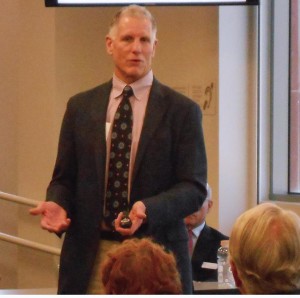
Stephen Sexauer spoke to RESDC members at the RESDC meeting on January 28th at SDCERA.
At the RESDC January 28th meeting, Mr. Sexauer walked through how he and his team have transitioned the retirement fund’s investments and what their long-term goals are. He presented his information in a simple, straightforward manner starting off with his definition of “What is a pension?” He defined it with three terms: 1. Savings, 2. Returns on the savings (investments), and 3. A regular and reliable paycheck, for life. He emphasized that what is difficult is making it last a lifetime, no matter how long you live. He pointed out that there are three things that make pensions so valuable:
- Longevity pooling
- The group (pool) saves for the average lifespan (85)
- The individual (you) saves for the maximum (105)
- If there were no longevity pooling, you need 50% more savings
- Professional management, working for you
- This includes actuaries, accountants, investors, and a payroll department
- Scale economies and lower costs
- By representing a large pool of members, wholesale purchases of services are possible
- In SDCERA’s case, the 40,000 members employ five investors to manage their investments for an 8,000 to 1 ratio
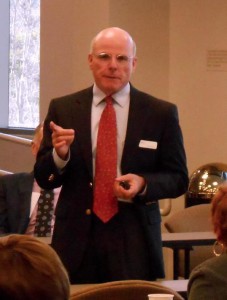
David Wescoe spoke to RESDC members at the January 28th meeting at SDCERA.
Mr. Sexauer summarized the objective of his work for us, the members of the SDCERA retirement system, as providing benefits to participants, minimizing employer contributions, and defraying expenses. They do that in a way that minimizes risk of loss while maximizing the rate of return, unless under the circumstances it is clearly not prudent to do so. And, he does it while trying to be responsible, accountable, and transparent to the SDCERA Board and members.
Turning to the $10 billion SDCERA pension portfolio, Mr. Sexauer emphasized that the portfolio is managed for the long term; daily or weekly peaks and valleys in the investment markets are not as much of a concern as the long-term trends in the investments. The SDCERA portfolio is diversified: by investment (risk-return) type, by geography, by fee type, by manager, and by liquid/illiquid. Mr. Sexauer concluded by pointing out that under the Investment Policy Statement adopted by the SDCERA Board, the returns in the portfolio should be expected to look similar to other California counties with similar objectives under the same laws that govern SDCERA. Those being the California State Constitution and the County Employees Retirement Law of 1937, which is commonly referred to as the “37 Act.” (There are 20 California counties that fall under the 37 Act.)
RESDC will continue to closely monitor the performance of the portfolio as reported by Mr. Sexauer to the Board of Retirement and will keep you apprised of how well the stated objectives are being met over time. Our First Vice President, Stan Coombs, has been following investments at SDCERA for many years and will continue to report what is happening with the funds that ultimately get used to pay our retirement benefit.
When is 2% and 3%, Not 2% and 3%?
By Stan Coombs
On Thursday, February 18, 2016, the San Diego County Board of Retirement voted unanimously to increase all County pensions. Imagine that!
The Board really had no choice. It’s called a Cost of Living Adjustment (COLA), and they were only following the law. The increases aren’t much, probably average about $43 per month per retiree, but in the common vernacular, it’s better than a poke in the eye with a sharp stick!
Inflation is no small threat to the elderly. The National Institute on Retirement Security points out that 3% annual inflation reduces purchasing power of a woman’s $2,000 monthly pension by more than 50%, to only $993 over the 23 years between 62 and 85, her lifetime expectancy. Social Security has full inflation protection, but about half of all schoolteachers and most public safety workers aren’t covered. They are particularly vulnerable. And, current low inflation notwithstanding, the Bureau of Labor Statistics reports annual inflation averaged 2.79% over the past 30 years, ranging as high as 6.16% in 1982.
The California 1937 Retirement Act authorizes county pensions to be adjusted by the amount of the increase in the “Consumer Price Index For All Urban Consumers” (CPI), upon approval of that option by local Boards of Supervisors. The San Diego County Board of Supervisors approved the option, adding the COLA to the county retirement plan in 1972. County COLAs were capped at 3% for Tiers I, II, and A, and 2% for Tiers B and C.
This year our Board of Retirement Actuary, Segal Consulting, determined that the ratio of the past two annual San Diego CPI indices, April 1, 2014 and March 31, 2015, showed a 1.62% increase, which the law says must be rounded to the nearest one-half percent, or 1.5%. Enter the COLA Bank.
Any year when the CPI exceeds the 3% and 2% caps, let’s say 4%, county retirees receive their maximum 3% and 2% COLA increases, and the remaining 1% and 2% CPI growth is held in their COLA Bank. Several years of CPI increases in excess of the caps causes the COLA Bank balances to grow, and in years when the CPI increase is less than the applicable cap, that banked “value” is used to bring COLAs up to the 3% and 2% maximums.
Thus, actual COLA increases received by pensioners vary depending on CPI changes, the retiree’s Tier, the maximum COLA increase allowed for the particular Tier, and the amount of “value” available in the particular pensioner’s COLA Bank.
This year, actual increases will range from 3% for those retired before March 31, 1989 and who have enough value in their COLA Banks to maximize their COLAs, to 1.5% for those who retired later, and missed years of high CPI increases. Confusing enough? Bottom line – some county retirees will get 3% COLAs, most will get 1.5%, effective in April.
An interesting sidelight; some Tier II’s, who retired before 2000, received higher total COLAs this year than many Tier I’s and A’s, because they were retired during high CPI increase years, allowing their COLA Bank balances to climb. And, their 2% COLA cap had limited earlier drawdowns that would otherwise have exhausted their COLA Banks.
So, now that we think we understand COLAs, is there more to the picture? Yes! COLAs as well as most other features of secure, defined benefit retirement systems are under fire.
Most state and local governments provide some sort of COLAs to offset inflation. Four types are common: fixed-rate COLAs, using a constant percentage increase unrelated to the CPI; CPI-linked COLAs; ad hoc COLAs, approved only at the unscheduled whim of governing boards; and, investment-based COLAs, usually tied to investment performance or the level of assets in a COLA fund. The Public Fund Survey reports that approximately three-quarters of the COLAs are automatically initiated.
Between 2010 and 2013, the period following the great economic crash, 17 states with 30 retirement plans, reduced, suspended, or eliminated COLAs for current workers, and some for current retirees, according to The Center for Retirement Research at Boston College. The states eliminated COLAs for the foreseeable future, reduced guaranteed fixed amounts or reduced COLA caps.
According to the report, entirely eliminating a 2% compounded COLA reduces lifetime benefits by 15% to 17%, and eliminating a 3% COLA reduces lifetime benefits by 22% to 25% percent. Reductions in guarantees or lowered caps have a lesser impact.
In most cases the states were able to diminish COLAs because courts found no formal contract existed between employers and employees that would have been protected by the constitutional “contract clause.”
Just one more concern for allegedly “pampered” public employees.
San Diego County retirement net assets decreased $279.2 million during January, bringing fiscal-year-to-date changes to minus $521.3 million and total net assets to $9.8 billion.
Save the Date – RESDC Day with the Padres!
June 15, 2016

On July 1, 2015, RESDC members enjoyed an afternoon game at Petco Park. It was a great day of fellowship, food, and baseball as the Padres played the Seattle Mariners.
The crack of the bat, the smell of the grass, the 7th inning stretch…What does this all mean? Well of course…baseball season is here! In the words of the late great Yogi Berra, “Love is the most important thing in the world, but baseball is pretty good too.”
I’m pleased to announce RESDC will be hosting another “Day with the Padres.” This event is in response to surveyed RESDC members who have asked that we provide day trips and other group events to our members.
RESDC members will attend a game at beautiful Petco Park on Wednesday, June 15, 2016 at 12:40 p.m. as the Padres take on the visiting Miami Marlins. We have once again secured the scenic Skyline Patio, which includes box-style ballpark seats, a semi-private group area which overlooks third Base and as the photos to the right show, features gorgeous views of downtown San Diego.
Tickets include a pre-game buffet with standard ballpark fare, served one hour before first pitch until one hour after first pitch, and soft drinks served from one hour before first pitch through the seventh inning.
Fifty tickets are available on a first come, first serve basis. Ticket price is $43.00 per person. To purchase tickets, send a check made out to RESDC, to 8825 Aero Dr., Suite 205, San Diego, CA 92123. Tickets will be mailed to you.
I look forward to seeing you at the game!
Mark Nanzer
Executive Director
Pension Facts
Pension Facts at a Glance
0.7%
Degree that Defined Benefit plans out-performed 401(k) accounts over 22 years (1990-2012), according to a December, 2015 report from the Center for Retirement Research at Boston College.
By Chris Heiserman, Director
Anyone following RESDC regular columns in THE NETWORK has read that public pension opponents favor replacing Defined Benefit (DB) retirement plans with 401(k) accounts more prevalent in the private sector. Of course, the major difference between DB and 401(k) plans is the guarantee of pension checks for life (aka a more secure retirement) versus fixed personal investment accounts with individuals responsible for investing their savings and making them last as long as possible.
DB pension detractors argue that providing retirement security to public workers costs too much. We, of course, disagree and keep pointing out that DB plans are not only affordable, they are the most effective way to produce reliable and stable retirements.
On the other hand, it is well documented that a substantial portion of American families are not salting away enough savings for a decent quality of life after their working years. A Federal Reserve Board survey has reported that the median balance in a 401(k) type account for workers in the 55-64 age range was $60,000. If this amount was converted to an annuity, it would provide less than $400 a month over a typical retirement span.
Even coupled with Social Security, this modest monthly income stream translates into a lifestyle of bare subsistence. This picture paints the concerning scenario of a retirement “crisis” facing America and prompting bigger and bolder media headlines as it sinks in that much of our aging population will be wrestling with a bleak economic future.
In addition to the fact that accumulated dollars in 401(k) accounts are generally too small to generate a significant monthly annuity, there is evidence that overall investment earnings in 401(k)s lag behind when compared to the performance of DB plans. In a December 2015 report from the Center for Retirement Research at Boston College, analysts found that over a 22-year period (1990-2012) DB plans produced 0.7% more in investment earnings than 401(K) accounts.
The report identified investment fees as a primary reason for the lower performance by 401(k) accounts. It said fees account for 80-90% of total investment expenses, and mutual fund investing – the staple for 401(k) accounts – typically carries higher fees. According to the report, mutual funds charge fees for researching and selecting stocks, and assess the fees as a percentage of invested assets, thus lowering investment returns.
The under-performance of 401(k) accounts compared to DB plans by 0.7% may not seem like a lot, except when you consider the long time horizon for pension and retirement activities. In the conclusion of the Center for Retirement Research report, the authors make a telling comment when pondering the many years of foregone returns and reduced retirement assets. They said, “Saving is too hard to have fees eat up such a large portion of investment earnings.”
Board Member Profile
 Carlos Gonzalez — A member of the RESDC Board of Directors since 2009, Carlos retired from the San Diego County Superior Court with 18 and a half years of County service. He also served his country in the United States Marine Corps, retiring as a Gunnery Sergeant, and acquired accounting and auditing skills working in the savings and loan industry.
Carlos Gonzalez — A member of the RESDC Board of Directors since 2009, Carlos retired from the San Diego County Superior Court with 18 and a half years of County service. He also served his country in the United States Marine Corps, retiring as a Gunnery Sergeant, and acquired accounting and auditing skills working in the savings and loan industry.
Carlos served three terms on the San Diego County Retirement Association (SDCERA) Board (1992-2003). His volunteer and enjoyable activities in retirement include coin and stamp collecting, golf, walking, nature, and wine. Besides his service on the RESDC Board, Carlos sits on the Executive Committee as Treasurer of the California Retired County Employees Association (CRCEA).
Carlos returns frequently to his native Puerto Rico, and enjoyed a three-week, six-country tour of Europe in 2009. He has been married 44 years and has one child and two grandchildren.
Bits and Pieces
Carlos Arias celebrated his 80th birthday on February 14th! He is a Saint Valentine’s boy! He retired from Parks and Recreation in 1999 after about 15 years with the County. As an architect, he enjoyed his work as Project Manager on multiple projects such as the new community centers in Alpine and Lindo Lake Park, as well as the restoration of historical buildings at Heritage Park. In retirement, he shares his expertise and uses his knowledge of various foreign languages with his European colleagues in similar restoration projects. He just came back in time for a big birthday celebration with family and friends.
Marty Fink was selected as the 2015 Park Patrol Volunteer of the Year at Mission Trails Regional Park. Marty retired in 2013 from the Sheriff’s Department. Taking a page out of RESDC President John McTighe’s book, Marty has been volunteering at Mission Trails Regional Park since his retirement three years ago.
Edwin Kues celebrated his 87th birthday last month! Edwin retired in 1992 from the Probation Department. He and his wife will soon travel to her home town, Kyoto, Japan to attend her grammar school reunion which she does every other year.
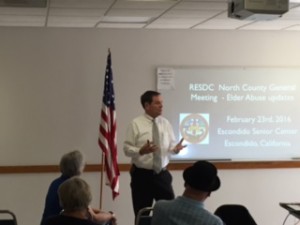 |
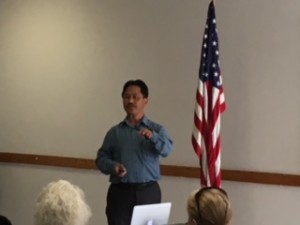 |
| RESDC Members met on February 23rd for the North County General Membership Meeting in Escondido. Paul Greenwood, Deputy District Attorney, Head of Elder Abuse Unit discussed prevention of fraud and scams targeted at elder populations. Also at this meeting, Adonis Relieve from Military & Veterans Affairs highlighted several programs and services for veterans. | |
Editor’s Note: We would like to continue printing some Bits and Pieces items in this newsletter about our members. If you have taken an interesting trip or have had an intriguing event happen recently, please let us know so that we can share your story with our members. If you have reached an 80th (or more) birthday, or 50th (or more) wedding anniversary, please call Karen Hazel at (866) 688-9229 or write RESDC, 8825 Aero Dr., Suite 205, San Diego, CA 92123. You may also send your information to us by e-mail at resdc@resdc.net.
San Diego County Credit Union

Identity theft is one of the fastest growing crimes in the United States. There are steps you can take to minimize your risk of identity theft including: destroying unused checks and credit cards, taking extra security with online purchases, being aware of phone scams, and simply guarding your purse or wallet. Be sure you do not give out your personal information over the phone unless you are sure you know to whom you’re speaking. SDCCU® also encourages you to review your credit report at least once a year for free at www.annualcreditreport.com.
For information on what to do if you think you’ve become a victim of fraud or identity theft visit sdccu.com and search for identity protection.
Save the Date! Flag Day Luncheon June 16, 2016
 This year the RESDC Flag Day Luncheon will be held at a new location while the Ronald Reagan Community Center undergoes extensive renovation. Please join us at the La Mesa Community Center this year on June 16th for our annual luncheon. Look for more information and reservation forms in the May and June issues of THE NETWORK.
This year the RESDC Flag Day Luncheon will be held at a new location while the Ronald Reagan Community Center undergoes extensive renovation. Please join us at the La Mesa Community Center this year on June 16th for our annual luncheon. Look for more information and reservation forms in the May and June issues of THE NETWORK.
Welcome New Members
Sheryl Alyea – Superior Court
Joanne L. Calhoun – SDCERA
Sylvia Nelson – Health & Human Services
Edith R. Porter – District Attorney
Gloria L. Shepard – Sheriff
Elma G. Torres – Health & Human Services
Grace Young – Health & Human Services
In Memoriam
Gene B. Agustin – Surviving Spouse
Barbara S. Aikin – Surviving Spouse
Annie L. Anderson – Health & Human Services
Joyce B. Bailey – Social Services
Marjorie Baxter – Health Services
Doris M. Cabaniss – Health Services
Anita S. Cohen – Social Services
Shirley I. Cruse – Surviving Spouse
Shirley J. Cullison – Surviving Spouse
Zenaida R. Deguzman – Treasurer-Tax Collector
Richard B. Empey – Planning & Land Use
Mary Jane Everett – Surviving Spouse
Joann S. Fenn – Health & Human Services
Barbara J. Fong – County Counsel
Valerie M. Gulyas – District Attorney
Wilfred E. Herill – Sheriff
Richard J. Heil – Assessors
Kathryn M. Judd – Agriculture
Edward G. Koessner – Public Works
Cynthia K. Krutsch – Public Works
Linda L. Leach – Public Works
Eleanor I. Martin – Surviving Spouse
John R. McDaniel – Public Works
Catherine R. Morris – Auditor & Controller
Jorge Murua – Health & Human Services
Arvis J. Myers – General Services
Marjorie F. Pemberton – Surviving Spouse
Emily M. Piner – District Attorney
Robert J. Polansky – Probation
Lee W. Ramsey – Social Services
Kathleen R. Rice – Library
Mary L. Ritter – Probation
Manuel Robles – Sheriff
Lucia Roe – Health Services
Elizabeth Salisbury – Surviving Spouse
Grace H. Sawasaki – District Attorney
Stephen O. Seibert – Public Works
Katherine Shaffer – Social Services
Catherin J. Swadley – Social Services
Therese L. Terry – Welfare
David Turosak – Public Works
William F. Valenzuela – Probation
Eileen Wyborney – Public Works
Gone from our sight, but never our memories.
Gone from our touch, but never our hearts.
The surviving spouse of a member is eligible for RESDC membership. For enrollment assistance, call (619) 688-9229.
Member Privacy
Any retiree or surviving spouse who does not want his/her death notice published in the “In Memoriam” section of this newsletter may notify the RESDC office and your privacy will be maintained.
NETWORK is the official monthly newsletter of the Retired Employees of San Diego County, Inc. (RESDC), a private non-profit organization.
The information printed in the NETWORK is believed to be from reliable sources. However, no responsibility is assumed by the NETWORK for inaccuracies contained herein.
Business and Inquiries: Business matters and address changes may be recorded on our voicemail at any time, call (866) 688-9229. Please spell your name so the correct member record can be located.
Retired Employees of San Diego County, Inc.
8825 Aero Drive, Suite 205 | San Diego, CA 92123
Office Hours: 9 a.m. to 2 p.m. Monday through Friday
TELEPHONE: (866) 688-9229 Toll Free
FAX: (619) 688-0766
E-MAIL: resdc@resdc.net

